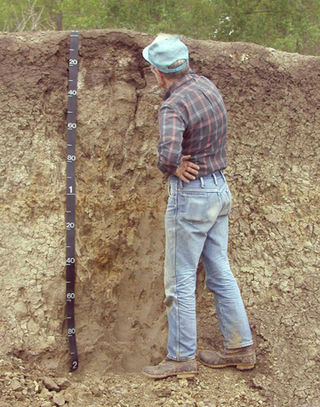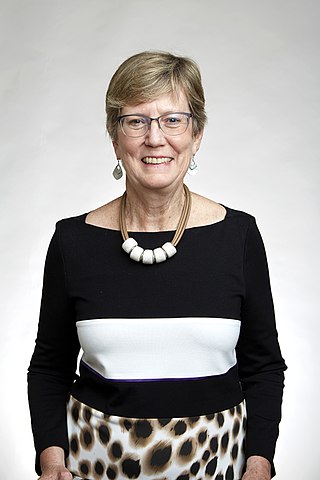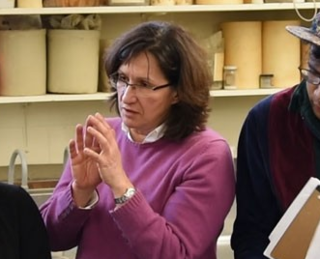Related Research Articles

Physical geography is one of the three main branches of geography. Physical geography is the branch of natural science which deals with the processes and patterns in the natural environment such as the atmosphere, hydrosphere, biosphere, and geosphere. This focus is in contrast with the branch of human geography, which focuses on the built environment, and technical geography, which focuses on using, studying, and creating tools to obtain, analyze, interpret, and understand spatial information. The three branches have significant overlap, however.

Soil science is the study of soil as a natural resource on the surface of the Earth including soil formation, classification and mapping; physical, chemical, biological, and fertility properties of soils; and these properties in relation to the use and management of soils.

The American Educational Research Association is a professional organization representing education researchers in the United States and around the world. AERA's mission is to advance knowledge about education and promote the use of research in educational practice.

The Soil Science Society of America (SSSA), is the largest soil-specific society in the United States. It was formed in 1936 from the merger of the Soils Section of the American Society of Agronomy and the American Soil Survey Association. The Soils Section of ASA became the official Americas section of the International Union of Soil Sciences in 1934, a notable role which SSSA continues to fulfill.

The National Science Teaching Association (NSTA), founded in 1944 and headquartered in Arlington, Virginia, is an association of science teachers in the United States and is the largest organization of science teachers worldwide. NSTA's current membership of roughly 40,000 includes science teachers, science supervisors, administrators, scientists, business and industry representatives, and others involved in and committed to science education.

Epsilon Pi Tau is an international honor society for collegiate students and professionals in the field of technology. It recognizes the academics of students, preparation for practitioners, and outstanding professionals. It is a member of the Association of College Honor Societies.

The American Oil Chemists' Society (AOCS) is an international professional organization based in Urbana, Illinois dedicated to providing the support network for those involved with the science and technology related to fats, oils, surfactants, and other related materials.
The early concepts of soil were based on ideas developed by a German chemist, Justus von Liebig (1803–1873), and modified and refined by agricultural scientists who worked on samples of soil in laboratories, greenhouses, and on small field plots. The soils were rarely examined below the depth of normal tillage. These chemists held the "balance-sheet" theory of plant nutrition. Soil was considered a more or less static storage bin for plant nutrients—the soils could be used and replaced. This concept still has value when applied within the framework of modern soil science, although a useful understanding of soils goes beyond the removal of nutrients from soil by harvested crops and their return in manure, lime, and fertilizer.
The Materials Research Society (MRS) is a non-profit, professional organization for materials researchers, scientists and engineers. Established in 1973, MRS is a member-driven organization of approximately 13,000 materials researchers from academia, industry and government.
The American Physiological Society is a non-profit professional society for physiologists. It has nearly 10,000 members, most of whom hold doctoral degrees in medicine, physiology, or other health professions. Its mission is to support research and education in the physiological sciences. The society publishes 16 peer-reviewed journals, sponsors scientific conferences, and sponsors awards to further this mission.

Nancy Margaret Reid is a Canadian theoretical statistician. She is a professor at the University of Toronto where she holds a Canada Research Chair in Statistical Theory. In 2015 Reid became Director of the Canadian Institute for Statistical Sciences.
Argillipedoturbation, sometimes referred to as self-mulching, is a process of soil mixing caused by the shrinking and swelling of the smectite clays contained in soil. It is an effect specific to soils of the vertisolic variety, and is triggered by the constant cycles of wetting and drying It is characterized by wide, deep vertical cracks in the solum that contain differing materials from the rest of the soil layer they are found in, as well as sloughed-in surface materials. In order for argillipedoturbation to occur, the soil must be at least 30% clay content. The expression of argillipedoturbation depends to a large degree on the exact clay content of the soil, as well as on what other minerals make up the soil composition.

Jnanendra Nath Mukherjee CBE, FRSC was an Indian colloid chemist.

Maja Krzic is a soil scientist and an associate professor in the Department of Forest & Conservation Sciences in the Faculty of Forestry with a joint appointment in the Applied Biology and Soil Sciences programs in the Faculty of Land and Food Systems at the University of British Columbia. She is a founder of the Virtual Soil Science Learning Resources Group, a collaborative teaching effort among scientists, students, and multimedia experts from seven universities and three research institutions in Canada that create open access soil science educational resources. She is also the president of the Canadian Society of Soil Science and was named a 3M National Teaching Fellow in 2016.
Ivara Ejemot Esu OFR, is a Nigerian politician, academic administrator and professor and is the former Deputy Governor of Cross River State. He hails from Agwagune in Biase Local Government Area of Cross River State, Nigeria. He holds the Nigerian National Honours Award in the rank of Officer of the Order of the Federal Republic (OFR) conferred on him by President Obasanjo in 2005 and the Cross River State Honours Merit Award conferred on him by Governor Donald Duke in 2004 for carrying out excellent management reforms at the University of Calabar. Esu has held many positions of responsibility such as Vice Chancellor, University of Calabar (2000–2005); Honourable Minister of State for Tourism, Culture and National Orientation ; Member, Technical Committee on Privatization and Commercialization (TCPC), Presidency, Lagos (1990–1992); Honourable Commissioner for Agriculture, Water Resources and Rural Development Cross River State (1992–1993); Chairman Federal Medical Centre Board, Owerri (2009–2011) and chairman, Nnamdi Azikiwe University Teaching Hospital, Nnewi (2012–2015) and was an Elder Statesman Delegate at the 2014 National Conference of Nigeria. Esu is a Soil Scientist (Pedologist) who has taught in various tertiary institutions, some of which include; the Kaduna Polytechnic; Ahmadu Bello University Zaria, University of Calabar, University of Uyo and the University of Ghana, Legon, Accra.
Cynthia Grant is a former Canadian federal scientist who is an expert in soil fertility and crop nutrition. She was a researcher with Agriculture and Agri-Food Canada (AAFC) (1986-2015). Her research provided the scientific foundation for the Made-in-Canada 4R nutrient stewardship framework that applies crop nutrients from the right source and at the right rate, time and place. Grant is now part of an elite group of ten women who have been inducted into the Canadian Agricultural Hall of Fame since 1960.
Barbara Cade-Menun is a research scientist with Agriculture and Agri-Food Canada at the Swift Current Research and Development Centre in Saskatchewan. Her research focuses on nutrient cycling and minimizing nutrient loss from agriculture and she is a world leader in studying phosphorus cycling in water, soils, and plants. She is recognized for her pioneering work in the use of 31P nuclear magnetic resonance spectroscopy to characterize phosphorus compounds in soil and other environmental samples. She has developed and refined investigative techniques in her field that have become the preferred standard.

Charles Ng Wang-wai is the first CLP Holdings Professor of Sustainability and Chair Professor in the Department of Civil and Environmental Engineering at the Hong Kong University of Science and Technology (HKUST). He is also the vice-president of HKUST (Guangzhou) and the dean of the Fok Ying Tung Graduate School at HKUST, Clear Water Bay Campus. He is the immediate past president of the International Society for Soil Mechanics and Geotechnical Engineering (ISSMGE), where he served as the 17th President from 2017 to 2022.
G. Clarke Topp is a Canadian soil physicist who spent 37 years with Agriculture and Agri-food Canada, Ottawa. His research focus was to improve field measurement methods for soil-water properties and parameters. His research introduced electromagnetic (EM) technology to soil measurement by way of Time Domain Reflectometry (TDR). Topp is recognized for outstanding technical innovation and scientific achievement.
Noura Ziadi is a Canadian research scientist with Agriculture and Agri-Food Canada (AAFC), at the Quebec Research and development centre, whose research focuses on soil fertility and plant nutrition. She has developed technologies, methods, and knowledge for better management of mineral fertilizers that increase their efficiency while reducing environmental impact. More specifically, Ziadi developed and validated models to diagnose nitrogen and phosphorus status for different crops, developed new technologies to ensure effective management of industrial wastes and biochar, and developed methods for soil analysis. Ziadi conducts her research on national and international scales in multidisciplinary teams that include government, university, and industry partners. Her research increases agricultural productivity and enhances environmental performance earning her recognition as an influential woman in agriculture.
References
- ↑ The Literature of soil science. McDonald, Peter, 1952-. Ithaca: Cornell University Press. 1994. pp. 127. ISBN 0801429218. OCLC 28708357.
{{cite book}}: CS1 maint: others (link) - ↑ Bulletin of the International Society of Soil Science: Bulletin de L'Association Internationale de la Science Du Sol. Mitteilungen Der Internationalen Bodenkundlichen Gesellschaft, Issues 87-91
- ↑ Council., Canadian Geoscience (1978). The geosciences in Canada, 1977 : annual report and review of soil science. Rutherford, G. K., Savage, P. J., Warkentin, Benno P. Ottawa: Geological Survey of Canada. ISBN 0660015382. OCLC 11050699.
- ↑ Carter, Martin; Gregorich, Edward (2008). Soil Sampling and Methods of Analysis. CRC Press and Taylor & Francis Group.
- ↑ Gregorich, Edward; Carter, Martin; Angers, Denis (2001). Soil and Environmental Science Dictionary. CRC Press.
- ↑ Carter, Martin (1993). Soil Sampling and Methods of Analysis. Lewis Publishers and CRC Press.
- ↑ "Virtual Soil Science Learning Resources". www.soilweb.ca. Archived from the original on 2014-12-18. Retrieved 2021-01-05.
- ↑ Krzic, Maja; Wilson, Julie; Basiliko, Nathan; Bedard-Haugh, Angela; Hymphreys, Elyn; Dyanatkar, Saeed; Hazlett, Paul; Strivelii, Rachel; Crowley, Chris (2014). "Soil 4 Youth: Charting New Territory in Canadian High School Soil Science Education". Natural Sciences Education. 43: 73–80. doi:10.4195/nse2013.11.0034.
- ↑ Diochon, Amanda; Basiliko, Nathan; Krzic, Maja; Yates, Thomas T.; Olson, Edith; Masse, Jacynthe; Amiro, Brian; Kumaragamage, Darshani (2016-10-12). "Profiling undergraduate soil science education in Canada: Status and projected trends". Canadian Journal of Soil Science. 97 (2): 122–132. doi: 10.1139/cjss-2016-0058 . hdl: 1807/75439 . ISSN 0008-4271.
